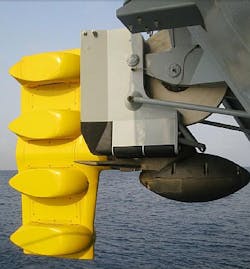Last of eight Royal Navy Duke-class frigates receives Thales sub-hunting toward-array sonar
The Portland is the final Royal Navy Duke-class frigate to receive the Thales UK Sonar 2087 anti-submarine warfare (ASW) sensor, and the warship has been returned to service with a rededication ceremony last month, Thales officials say.
The yearlong refit of the Portland’s sensors, weapons, and systems happened in Rosyth Royal Dockyard near Fife, Scotland. The refit helps ensure the upgraded ships are the most advanced of their kind in service, Thales officials say.
The combination of a Duke-class frigate fitted with the Thales Sonar 2087 and a Merlin helicopter equipped with the Thales FLASH dipping sonar makes the class the “most potent anti-submarine warfare platform of any navy at sea today," Royal Navy officials say.
Eight of the Royal Navy’s fleet of Duke-class frigates have been upgraded as submarine hunters. In addition to the Portland, the other seven upgraded Royal Navy Duke-class frigates are Westminster, Northumberland, Richmond, Somerset, Sutherland, Kent. and St Albans.
The Duke-class frigate Type 23 was designed as a light anti-submarine frigate to counter Soviet nuclear submarines operating in the North Atlantic as a replacement for the Leander-class frigates and the Type 21 frigate.
After the Falklands War in the early 1980s, however, the Duke-class design grew to include the Vertical Launch Sea Wolf (VLS) missile to defend against low-flying aircraft and sea-skimming anti-ship missiles, the Harpoon surface-to-surface missile, and a medium calibre gun for naval gunfire support. HMS Norfolk was the first of the class to enter Royal Navy service, and was commissioned on 1 June 1990.
Sonar 2087 is a low-frequency sonar with both active and passive sonar arrays. The system is manufactured at Thales sites in Cheadle and Templecombe, England, and Brest, France.
For more information contact Thales UK online at www.thalesgroup.com/Countries/United_Kingdom, or the Royal Navy at www.royalnavy.mod.uk.
